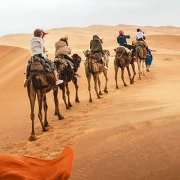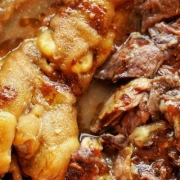Top 10 Countries for Camel Riding
Desert Landscapes are some of the most amazing natural wonders, and there are many ways to enjoy this gift of God. Watching stars, going for an off-road tour, and camel riding are fun things to do in the desert. Camel riding was a part of Middle Eastern and African culture and it was used as a way for transportation of long distances.
Today, it is seen as a fun way to enjoy the desert landscape, and many camel riding tours in different countries offer an unparalleled experience.
Where Is the Best Place to Go Camel Riding?
If you want to experience this lovely activity, it isn’t easy to choose a destination and pick a good camel riding tour. Nevertheless, we have brought some of the best places to go to camel riding with an expert tour and a fun crew.
Many countries focus on this kind of tourism, and it is the most healthy and fun activity, especially if you are visiting a Middle Eastern or African country. Countries such as Morocco, UAE, Egypt, Iran, Qatar, Jordan, Kenya, and Australia are mainland of camel riding and exploring the desert landscapes with passion.
Morocco
Morocco is a country that is famous for its history and Nomadic old tribes. Camel Riding was a great part of Moroccan people, and the Sahara Desert is one of the popular spots to go to for an exploration with a camel.
Many tour guides offer multi-day tours and exploration of deserts in Morocco, and a variety of tourists love to go on multi-day camel riding tours with old-stye Berber tents.

Stunning scenes of sunrise and sunset while riding a camel with your crew and enjoying traditional Moroccan meals are some of the most mesmerizing experiences that you can have.
Egypt
Known for its famous and legendary pyramids, which attract thousands of tourists from each corner of the world, Egypt also has a long-lasting connection with deserts and camel ridings.
If you are visiting Egypt for the first time and want to explore it all, especially the Pyramid of Giza, it is best to travel across it with camels and enjoy your camel rides. However, we should mention that there are lots of scammers, and we suggest you choose your tour guides wisely.
Egypt is the land of history and culture, and you will feel its depth by camel riding across its deserts.
Qatar
Nestled along the Persian Gulf, the country of Qatar is another gem in the Middle East. Although it has modernized and developed very quickly like its other neighbors, Qatar still values its cultural and historical elements.
Camel riding was also a popular activity for the old Qatari people and was the most common thing in the Arab world.

You can find a variety of tours and crews that invite tourists and newcomers to an outstanding experience with camels, 4×4 cars, and old tents. So, if you want to enjoy the other side of Qatar, you still have a chance to do it.
Jordan
Jordan is another must-see destination in the Middle East, with a rich history. Most people visit Jordan to not only enjoy its historical sites but also go for camel rides beneath the sun and explore the vast deserts of this country.
Camel riding is surely a fascinating experience and feels like a movie. You can find a variety of camel tours with experienced guides and leaders at Wadi Rum, which is a world heritage site situated approximately in the southern part of the country. The most common camel tours in Jordan are short-hour tours.
United Arab Emirates
Attracting tourists for its modern infrastructure, giant buildings, and luxury streets and shops, the country of United Arab Emirates is still one of the best destinations to expose yourself to the rich Arabian culture. Take a ticket to Dubai and reserve a camel riding tour in the Arabian deserts of this country and relax for a few days.
You can also find many camel farms that are super close to the city, and you can try camel ridings and learn more about them. It is highly recommended, especially if you want to travel with your family and seek adventure.
Kenya
Whenever you hear the name of this country, the first thing that pops into your mind is wildlife and adventures. Kenya is worldwide famous for its safari experiences and is a great part of the country’s tourism.

You can explore Kenya with camel rides and see zebras, giraffes, and other fascinating creatures along the way, as this country is the heart of wildlife and adventures.
Kenya is filled with different amazing locations, and all of them are a must-visit spot if you enjoy nature and wildlife. Make sure to visit Kenya and enjoy its camel riding tours.
Tunisia
Tunisia is one of the North African countries where you can also have great experiences of camel ridings among its vast desert landscapes. Many tourists can also try this country if they don’t want to visit Morocco again, as both of them are situated in North Africa.
You can book some of the best camel riding tours and enjoy a few nights in the deserts beneath the clear sky full of stars. Tunisia is famous for its kind and hospitable people, and you can easily discover the culture of its old tribes by camel riding tours and explorations in the desert.
Australia
Let’s move to other destinations in the world. Australia is one of the most amazing countries known for its vast landscapes, great wildlife, and diverse nature, providing a great experience for camel ridings and dessert tours.
There are many locations in Australia that offer an excellent opportunity for camel riding on the beach. Victor Harbor, Great Ocean Road, and Fraser Island are some of the spots where you can experience camel ridings along the beach with your friends and family.

Australia is the best place to experience another level of camel ridings and enjoy the relaxation of this activity along the beach.
Mongolia
Camels and Horses were a part of the identity of Mongolian people, and this identity has become one of the symbols of this country. In Mongolia, the ancient tribes commonly passed down the tradition of camel riding as a primary mode of transportation.
Today, camels are the most found creatures in the deserts of Mongolia. You can try different camel riding tours in Mongolia and visit their old tribes that usually live in the deserts and plains.
If you want to experience something unique in Central Asia, we highly recommend you visit Mongolia and experience the unforgettable camel riding tours.
Iran
Another destination where you can enjoy camel riding and adventure is Iran. Iran is a vast country and has some of the most famous desert landscapes in the world, such as the Maranjab Desert.
You can try camel riding tours in Iran with Matinabad Eco Resort, which invites tourists to an unseen experience in the deserts, with camels, tents, music, and traditional meals.

So, if you want to try out camel riding tours in the deserts of Iran, make sure to book Matinabad Eco Resort Camp camel riding tours to ensure the best experience for your adventurous journey.
Why Is Camel Riding Exciting?
Camel riding is an exciting experience. Because camels were not the typical type of transportation in many cultures, this can create a sense of adventure and fun and can connect us to ancient cultures. Camels were a great part of desert wildlife and nomadic tribes for centuries as they were immune to hot weather and low resources of water and food.
So, camel riding can evoke dramatic desert landscapes and make our experiences unforgettable while creating a peaceful and serene sense inside of us. Make sure to visit the mentioned countries to experience this lovely adventure.
Things to Know
If you want to try camel ridings, it is essential to consider a few things. For example, make sure to have enough water with yourself as the weather can get very hot. Moreover, camels are genuinely unpredictable yet kind animals.

Nevertheless, carefully listen to the instructions of your experienced camel guide. You should also wear appropriate footwear and clothing to ensure your safety and comfort during the ride. Read about what to wear in the Desert for a general overview.
Camel riding is deeply rooted in many cultures and destinations, and these animals are very respected among different cultures. Last but not least, make sure to bring your cameras with you to save this unforgettable experience.
Lastly
Camels were a long-time friend of humans and were used for transportation in history. They are truly fascinating creatures, and camel riding is one of the best activities to do in the desert. Today, there are lots of countries that offer a unique camel riding experience in their lovely desert landscapes.
Several camel riding tours in countries such as Iran, like Matinabad Eco-Camp, invite tourists and visitors to a unique and relaxing experience beneath the sun and along the dunes.
Are you planning to travel to Iran and looking for an Iran resort? Consider Matinabad Eco-resort.





















































